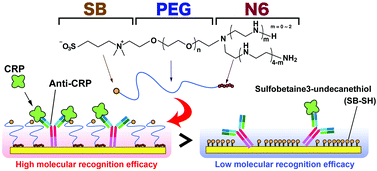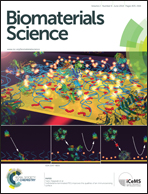Sulfobetaine-terminated PEG improves the qualities of an immunosensing surface†
Abstract
Poly(ethylene glycol) (PEG) possessing a sulfobetaine (SB) moiety at one end and a pentaethylenehexamine (N6) at the other end (SB–PEG–N6) was newly synthesized as a blocking agent for immunosensing surfaces. The N6 moiety strongly coordinates on gold surfaces, facilitating the tethering of the PEG chain to the sensor chip surface, and leaves the SB moiety free. Non-specific adsorption of bovine serum albumin (BSA) was analyzed on the SB–PEG–N6 tethered surface and compared with the methoxy-PEG–N6 (M-PEG–N6) tethered surface using a surface plasmon resonance (SPR) sensor. Non-specific BSA adsorption decreased with decreasing PEG chain length on the SB–PEG tethered chain surface. Non-specific adsorption of BSA decreased as ionic strength increased on SB–PEG–N6 surfaces; this phenomenon was completely opposite to that observed with an M-PEG–N6 tethered chain surface. The results show that SB moieties located close to the gold surface perform well with regard to protein rejection. Actually, low-molecular weight alkane thiol SB (SB-SH) showed minimum BSA adsorption. To evaluate protein recognition efficacy on a PEGylated surface, an antibody (IgG) immobilized surface was then constructed on a gold sensor chip using SB–PEG–N6 as the blocking agent. The specific protein recognition efficacy of SB–PEG–N6/IgG co-immobilized surfaces was higher than that obtained using SB-SH/IgG co-immobilized surfaces. We conclude that SB-terminated PEG exhibits the optimal qualities of a blocking agent, as it possesses both high suppression efficacy of nonspecific protein adsorption and specific protein recognition ability.


 Please wait while we load your content...
Please wait while we load your content...